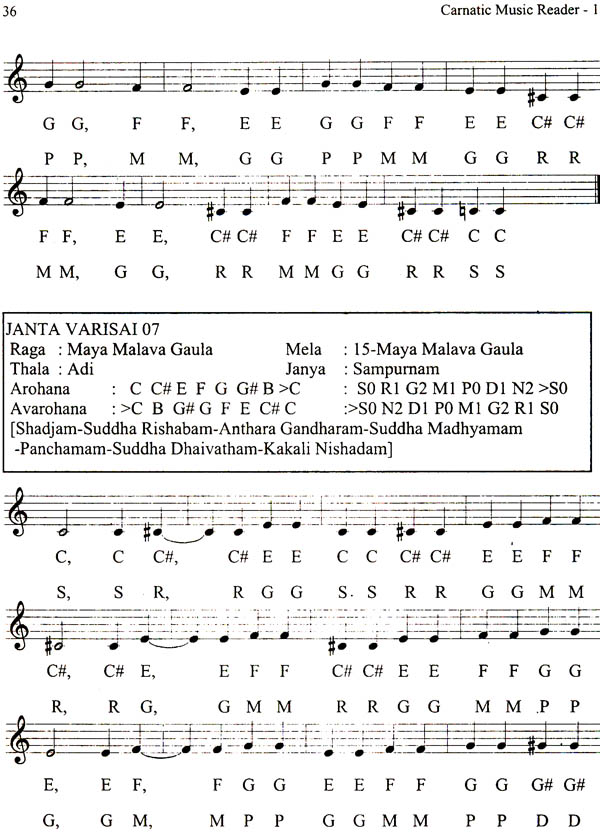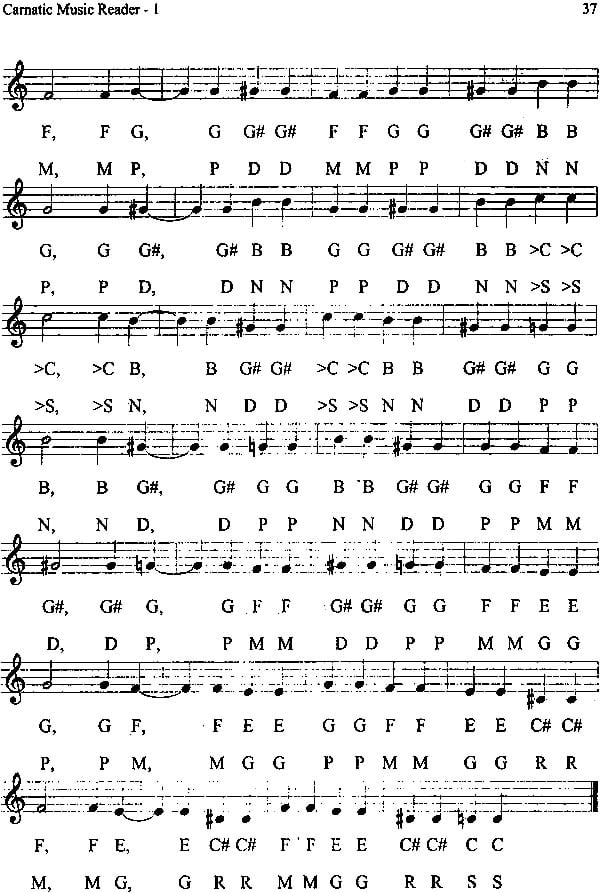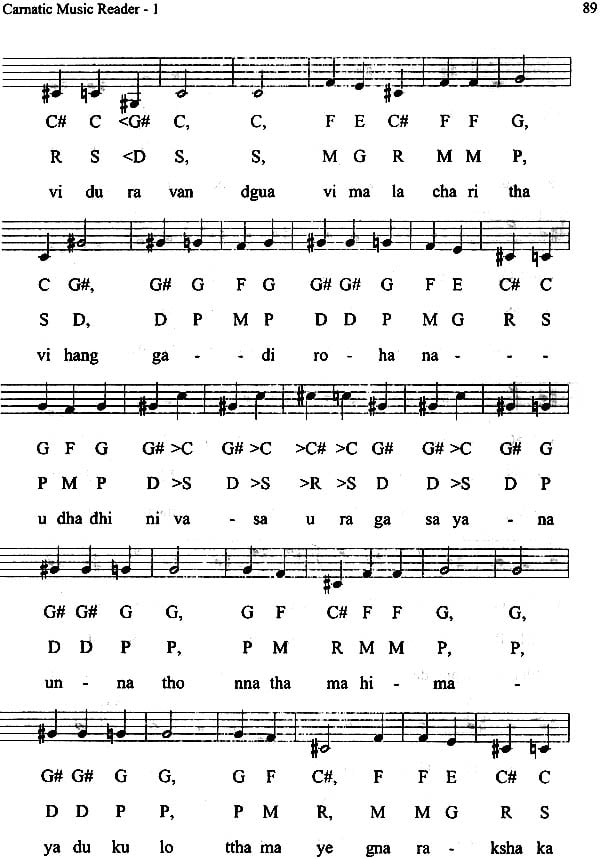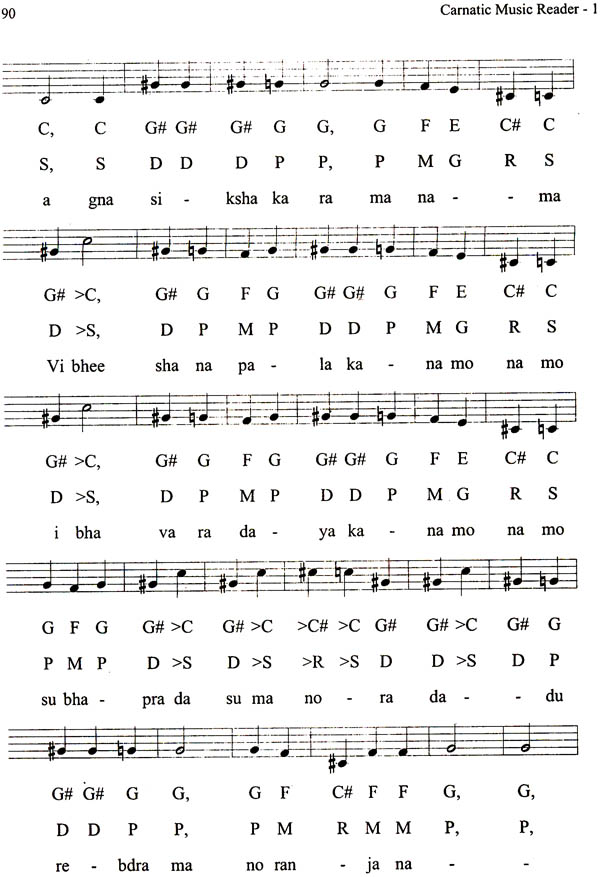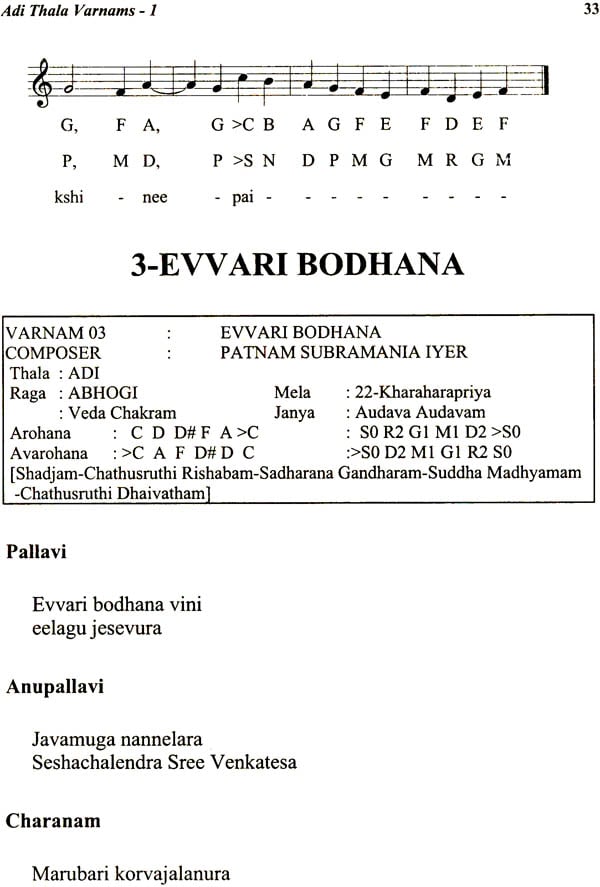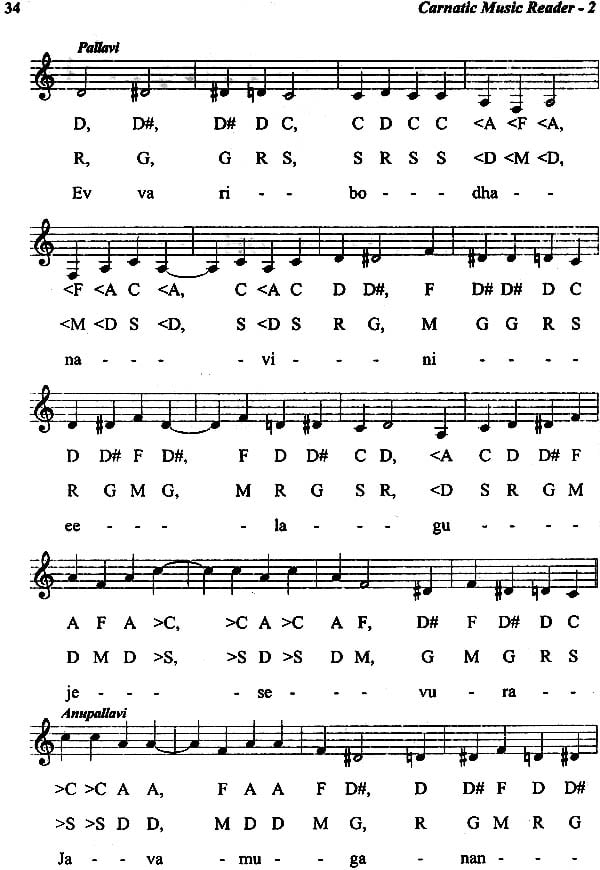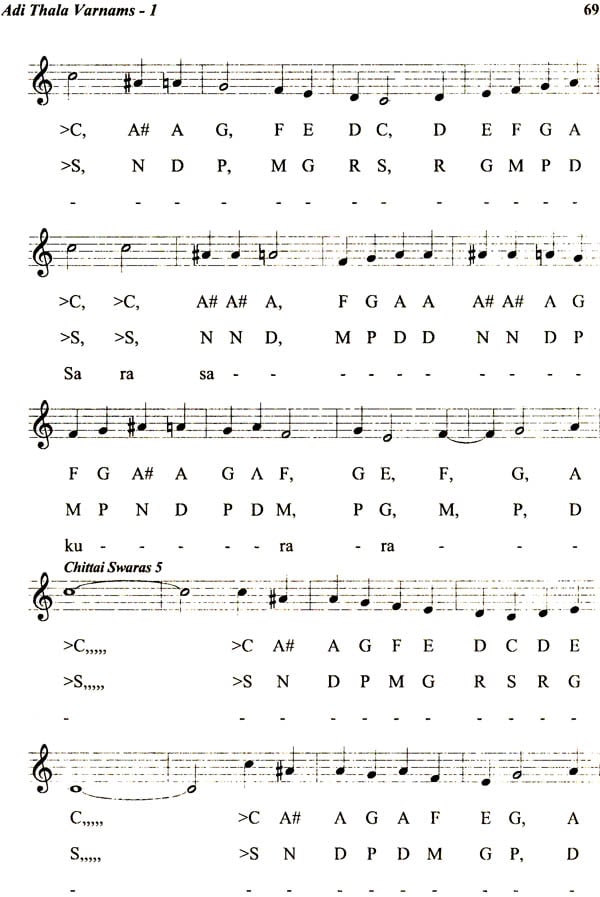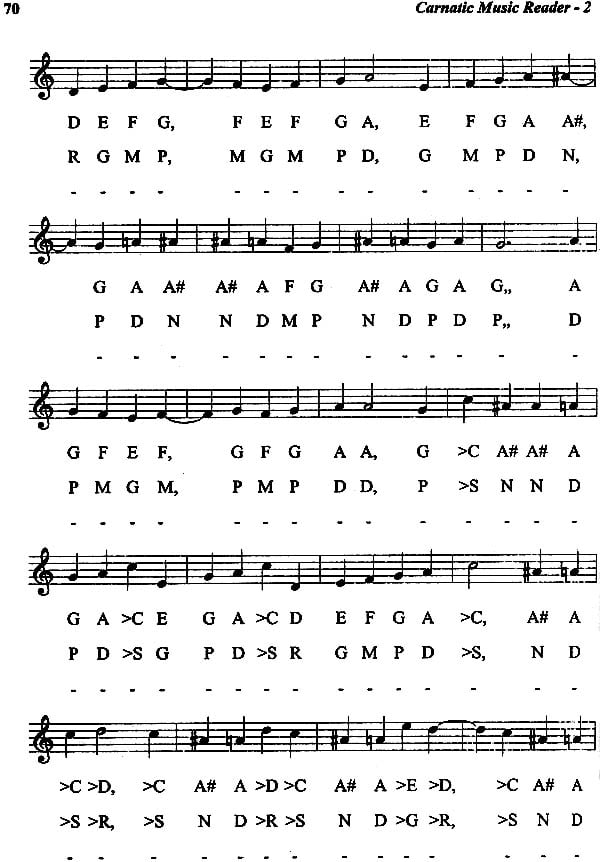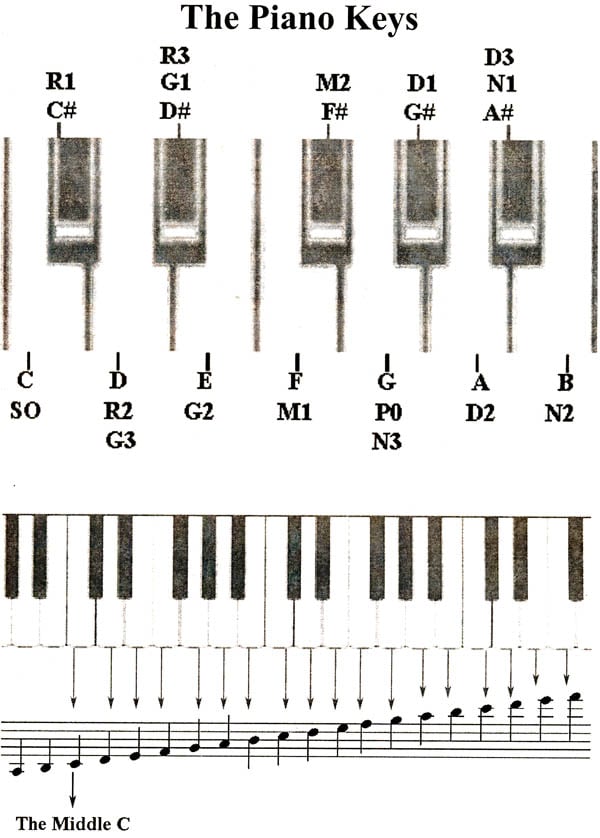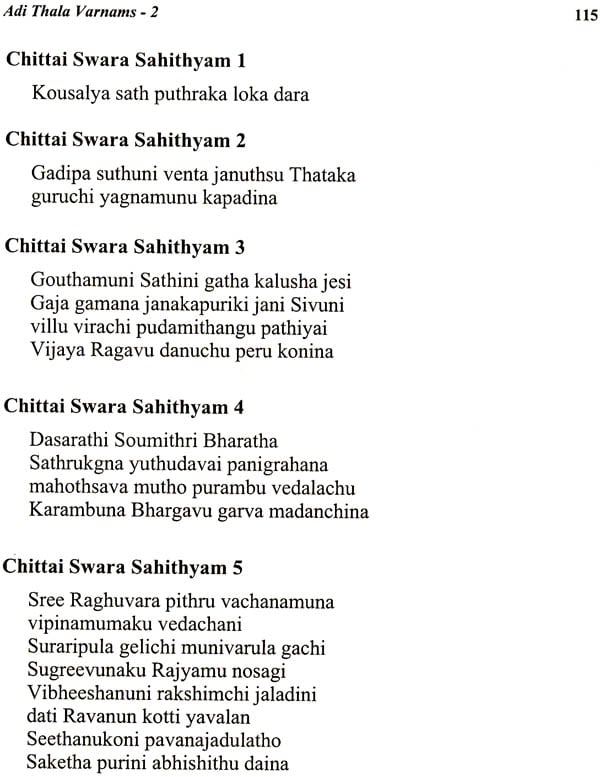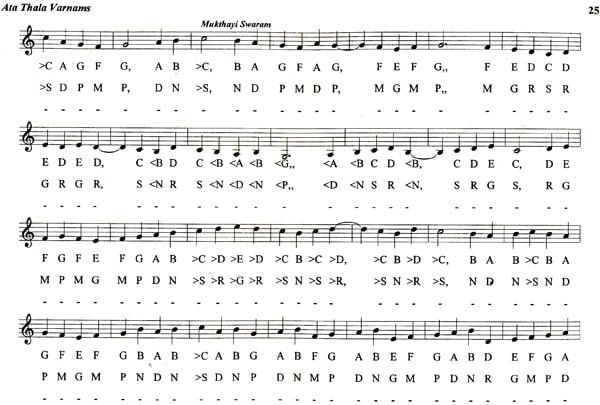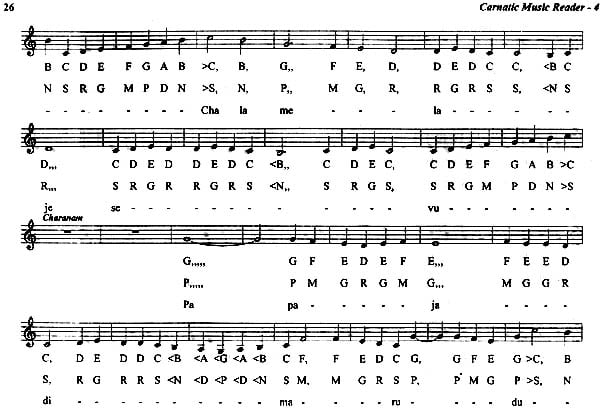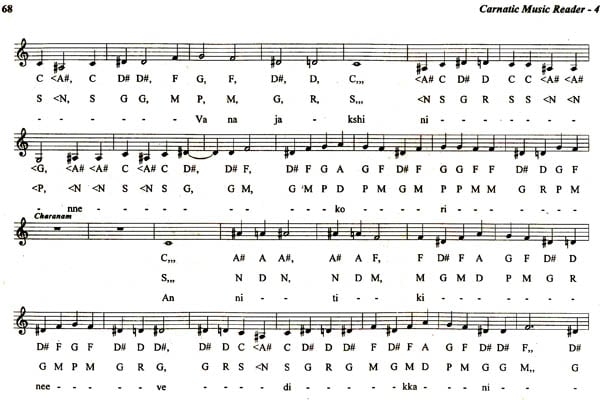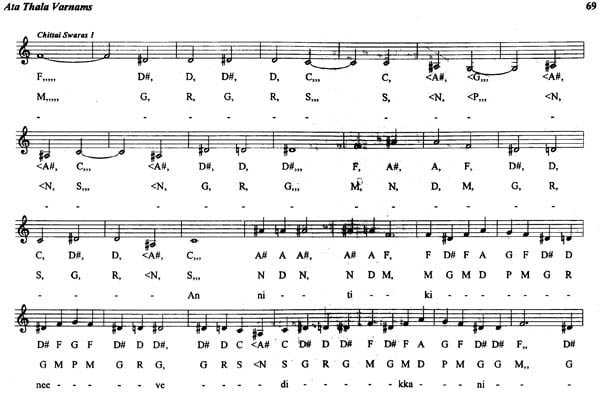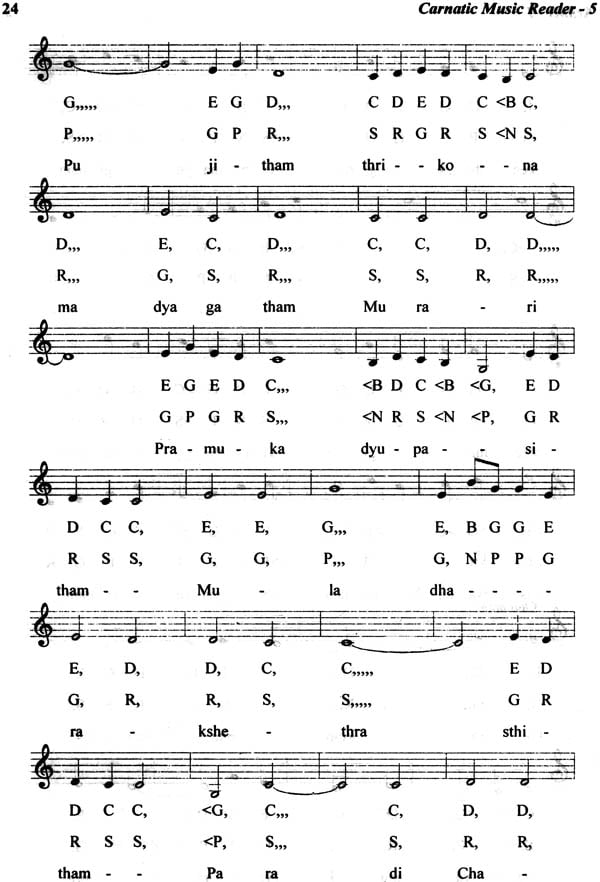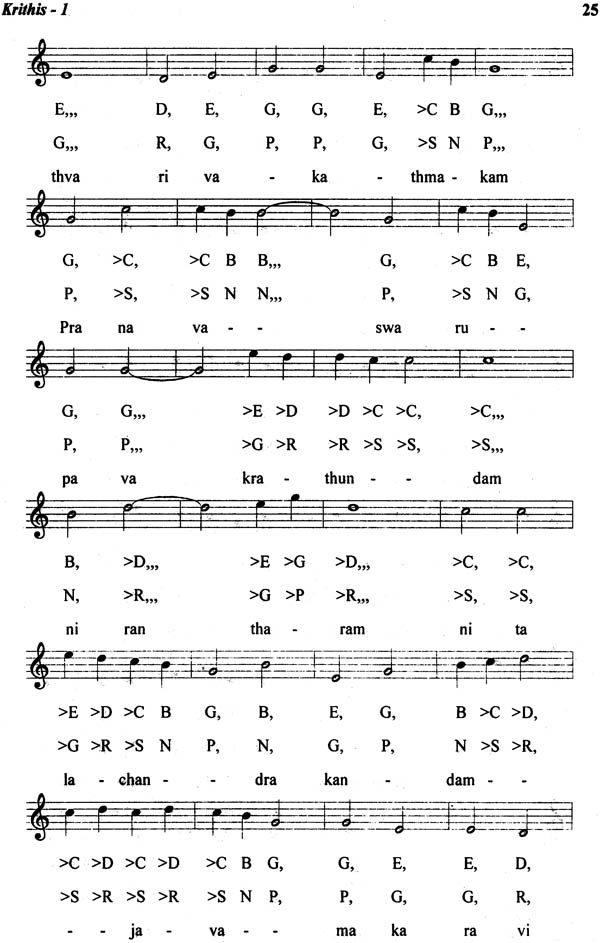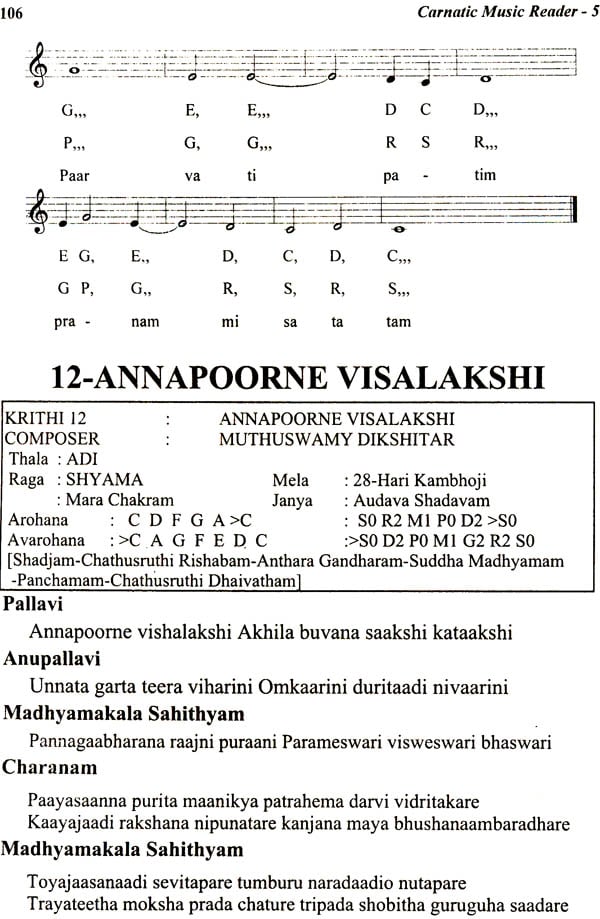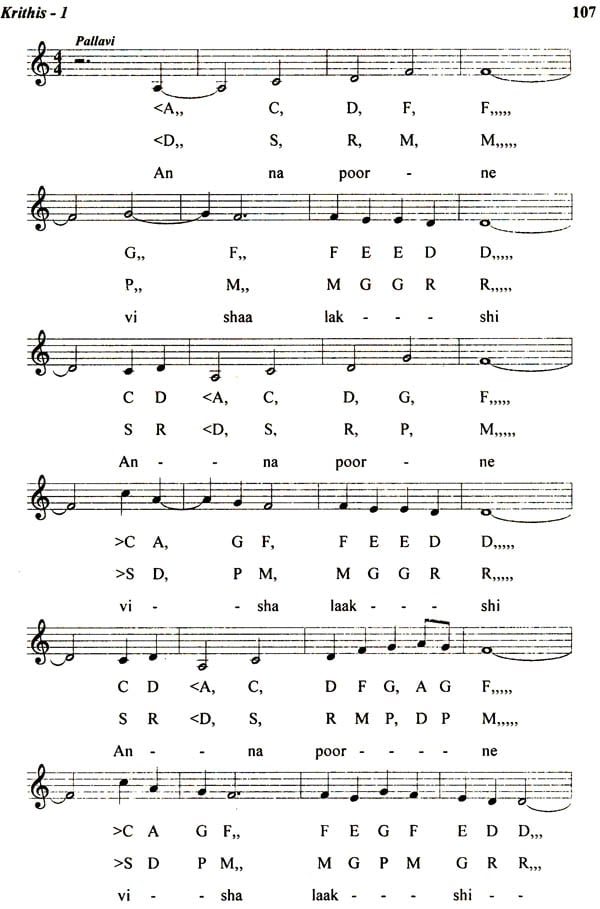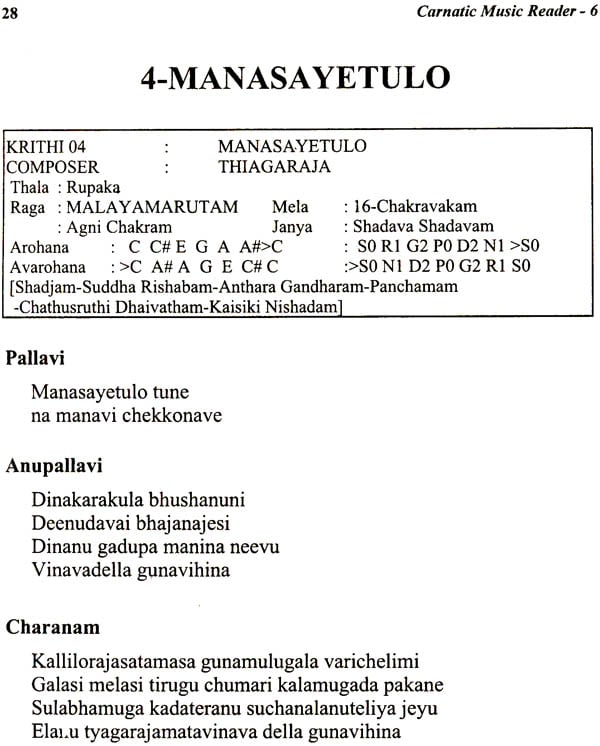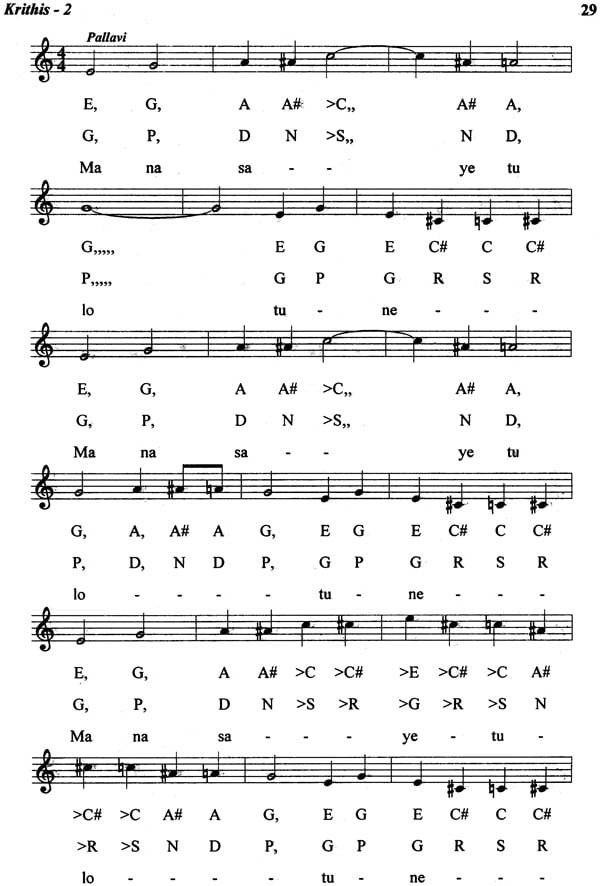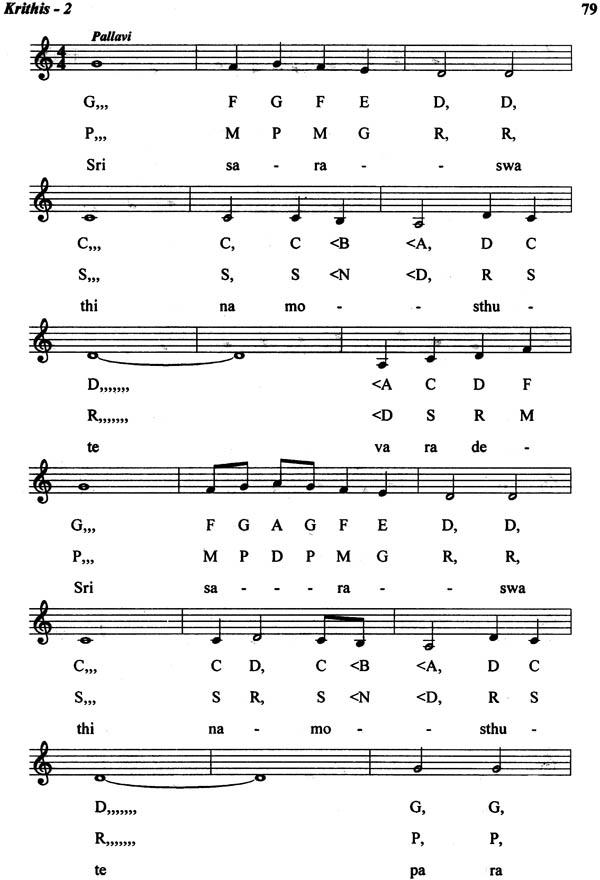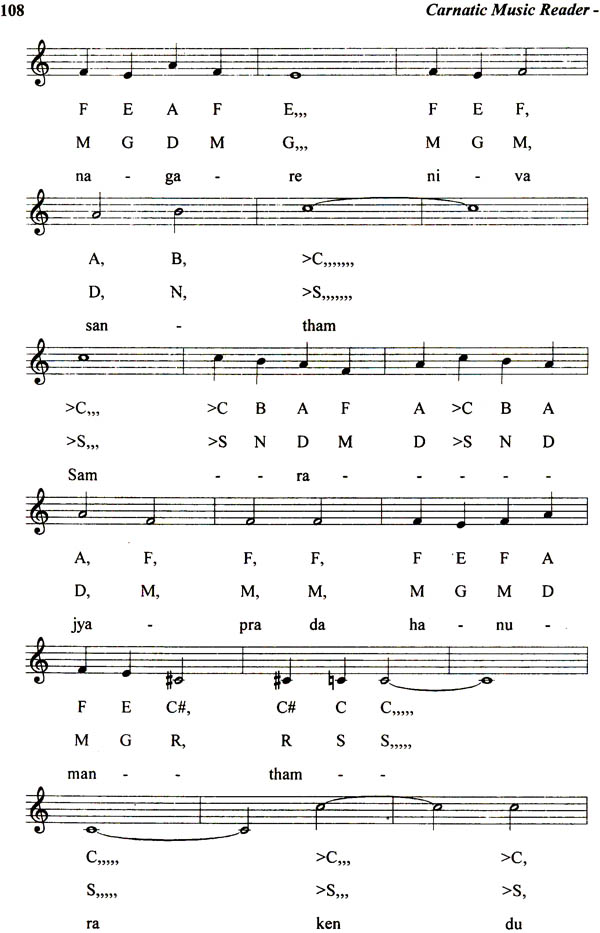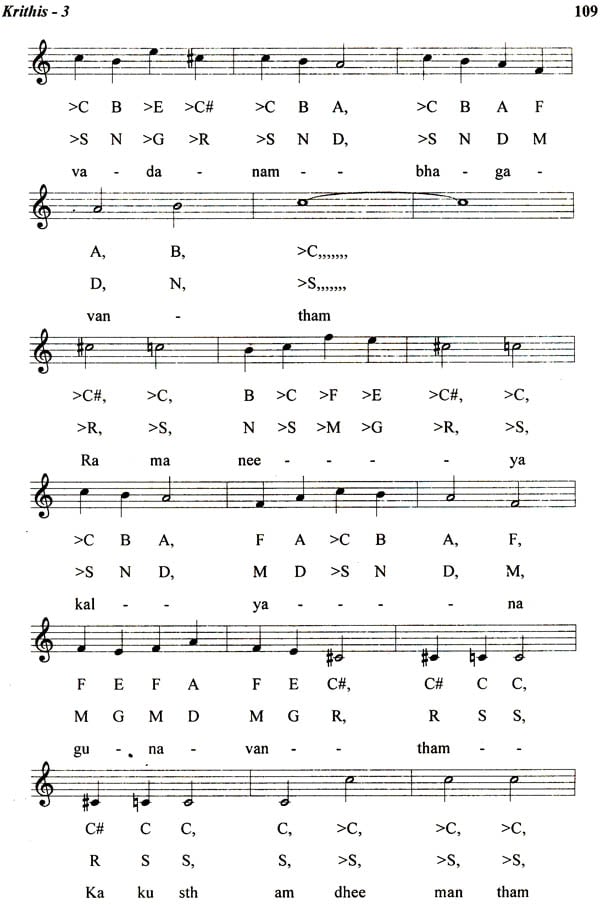
Carnatic Music Reader In Western Staff Notation (A Primer For Guitar, Piano, Keyborad, Saxophone, Violin) (Set of 7 Volumes)
Book Specification
| Item Code: | NAG721 |
| Author: | V. K. Krishna Prasad |
| Publisher: | CBH Publications |
| Language: | English |
| Edition: | 2015 |
| ISBN: | Vol I 9185381909, Vol II 8185381917, Vol III 8185381925, Vol IV 8185981933, Vol V 8185381941, Vol VI 818538195X, Vol VII8185381968 |
| Pages: | 932 |
| Cover: | Paperback |
| Other Details | 10.5 inch X 8.5 inch |
| Weight | 1.40 kg |
Book Description
The Carnatic Music Reader Series introduces a systematic study of Carnatic Music with the help of Western Staff Notation. The series has been designed with the beginner student in mind so that the he can learn to play the lessons on western instruments like guitar, piano, saxophone, violin etc. With little effort.
The first part of the series starts with a quick course on Western staff Notation and proceeds with the fundamental sequences of exercise in Carnatic Music for beginners.
All the exercises are graphically presented in Western Staff Notation, letter Notation and also the conventional Carnatic Letter Notation. All the fundamental sequences Sarali Varisai, Janta Varisai, Dhattu Varisai, sthayi Varisai, Alankaram, Geetham, Lakshana Geetham, Jathiswaram and Swarajathi are covered in the first series.
Lakhs of compositions - Thousands of Ragas - Hundreds of exercises - that is our Carnatic Music which is very rich in its resources. Carnatic Music is one of oldest form of the Classical Music Systems in the world. Over the centuries, it has been developed as the finest art form by the great masters of Carnatic Music. Though all the works have been documented and there are many books that cover the various aspects of Carnatic Music, most of them are in "Letter or Script Notation System."
Indian Carnatic Music in a recognizable universal format will make our Music works comprehensible by a large majority of Western and Indian Musicians who are familiar with Staff Notation System only The primary motivation in writing this book was to put together the basic exercises in the universal Western Staff Notation System which is a great tool for disseminating Musical information.
Western Staff Notation System is easy to learn, more graphical and gives a complete picture of the Music Score.
Thanks to Shri. M Easwaran of CBB Publications in showing interest in this project and publishing this Series.
I would like to thank to my family members and all friends who had been very appreciative of this endeavour.
The primary motivation in writing the Carnatic Music Reader series. was to put together the Basic Exercises, Varnams and Krithis in the universal Western Staff Notation System which is a great tool for disseminating Musical information.
Indian Carnatic Music in a recognizable universal format will III I make our Music works comprehensible by a large majority of Western and Indian Musicians who are familiar with Staff Notation System only Western Staff Notation System is easy to learn, more graphical and gives a complete picture of the Music Score.
The first book covered the basic exercises of Carnatic Music for beginners. This book, the second in the series covers some of the Adi Thala Varnams.
The lessons will be continued in same pattern for more Varnams and Krithis in the future volumes.
I have to thank Shri. M Easwaran for his encouragement in completing this task and Smt. Girija, Proprietor, CBH Publications in showing interest in this project and publishing this Series.
I would like to thank to my family members and all friends who had been very appreciative of this endeavour.
The Carnatic Music Reader Series presents the basic Exercises, Vamams and Krithis of Carnatic Music in the universal Western Staff Notation System. The First volume of the, series covered the basic Exercises for beginners. The Second volume covered some of the Adi Thala Varnams. This book, the third in the series covers more Adi Thala Varnams. Few Pada Varnams are also covered in this volume.
The lessons will be continued in the same pattern for more Vamams and Krithis in the future volumes.
Western Staff Notation System is easy to learn, more graphical and gives a complete picture of the Music Score. Those who are new to the Staff Notation System are requested to refer the initial volumes of the series where a brief and systematic introduction for the Western Staff Notation System is provided.
I have to thank Shri. M Easwaran for his continued encouragement in completing this task and Smt. Girija, Proprietor, CBH Publications in showing interest in this project and publishing this Series.
I would like to thank to my family members and all friends who had been very appreciative of this endeavour.
The Carnatic Music Reader Series presents the basic Exercises, Varnams and Krithis of Carnatic Music in the universal Western Staff Notation System. The First volume of the series covered the basic Exercises for beginners. The Second and Third volume covered the Adi Thala Varnams. This book, the Fourth in the series covers Ata Thala Varnams.
Western Staff Notation System is easy to learn, more graphical and gives a complete picture of the Music Score. Those who are new to the Staff Notation System are requested to refer the initial volumes of the series where a brief and systematic introduction for the Western Staff Notation System is provided.
I have to thank Shri. M Easwaran for his continued encouragement in completing this task and Smt. Girija, Proprietor, CBB Publications in showing interest in this project and publishing this Series.
I would like to thank to my family members and all friends who had been very appreciative of this endeavour.
The Carnatic Music Reader Series presents the basic Exercises, Varnams and Krithis of Carnatic Music in the universal Western Staff Notation System. The First volume of the series covered the basic Exercises for beginners. The Second, Third and Fourth volumes covered the Adi Thala and Ata Thala Varnams. Krithis were started in the Fifth Volume.
This book, the Sixth in the series covers more Krithis. Same pattern will be continued in future volumes of the series to cover more Krithis.
Western Staff Notation System is easy to learn, more graphical and gives a complete picture of the Music Score. For those who are new to the Staff Notation System, a brief and a systematic introduction for the Western Staff Notation System is provided.
I have to thank Shri. M Easwaran for his continued encouragement in completing this task and Smt. Girija, Proprietor, CBH Publications in showing interest in this project and publishing this Series.
I would like to thank to my family members and all friends who had been very appreciative of this endeavour.
The Carnatic Music Reader Series presents the basic Exercises, Varnams and Krithis of Carnatic Music in the universal Western Staff Notation System. The First volume of the series covered the basic Exercises for beginners. The Second, Third and Fourth volumes covered the Adi Thala and Ata Thala Varnams. Krithis were started in the Fifth Volume.
This book, the Sixth in the series covers more Krithis. Same pattern will be continued in future volumes of the series to cover more Krithis.
Western Staff Notation System is easy to learn, more graphical and gives a complete picture of the Music Score. For those who are new to the Staff Notation System, a brief and a systematic introduction for the Western Staff Notation System is provided.
I have to thank Shri. M Easwaran for his continued encouragement in completing this task and Smt. Girija, Proprietor, CBH Publications in showing interest in this project and publishing this Series.
I would like to thank to my family members and all friends who had been very appreciative of this endeavour.
The Carnatic Music Reader Series presents the basic Exercises, Vamams and Krithis of Carnatic Music in the universal Western Staff Notation System. The First volume of the series covered the basic Exercises for beginners. The Second, Third and Fourth volumes covered the Adi Thala and Ata Thala Varnams.
Fifth and Sixth volumes covered the Krithis. This book, the Seventh in the series covers more Krithis of various composers.
Western Staff Notation System is easy to learn, more graphical and gives a complete picture of the Music Score. For those who are new to the Staff Notation System, a brief and a systematic introduction for the Western Staff Notation System is provided in the initial volumes.
I have to thank Shri. M Easwaran for his continued encouragement in completing this task and Smt. Girija, Proprietor, CBH Publications in showing interest in this project and publishing this Series.
I would like to thank to my family members and all friends who had been very appreciative of this endeavour.
| l.Introduction | 1 |
| 2.Staff notation | 5 |
| 3.Excercises | 17 |
| 4.Sarali varisa | 21 |
| S.Janta varisa | 28 |
| 6.Dattu varisa | 46 |
| 7.Mandra sthayi varisa | 53 |
| 8.Madhya sthayi varisa | 56 |
| 9.Tara sthayi varisa | 59 |
| l0.Alankaram | 63 |
| 11.Geetham | 74 |
| 12.Lakshana geetham | 99 |
| 13.Jatiswaram | 105 |
| Introduction | 1 |
| Staff Notation - A Brief Introduction | 5 |
| 1.Ninnukori : Mohanam | 17 |
| 2.Sami Ninne : Shankarabharanam | 25 |
| 3.Evvari Bodhana : Abhogi | 33 |
| 4. Vanajakshiro : Kalyani | 41 |
| 5.Intha Chalamu : Begada | 50 |
| 6.Tharuni Ninnu : Kamboji | 61 |
| 7.Sarasuda Ninne : Saveri | 72 |
| 8.Jalajakshi : Hamsadhvani | 82 |
| 9.Inthamodi : Saranga | 92 |
| 10.Eranapai : Hanuma Thodi | 99 |
| 11.Ninne Kori : Vasantha | 108 |
| 12.Sami Ninne : Shree | 117 |
| 1.Intha Chouka : Bilahari | 1 |
| 2.Sami Ninne : Pantuvarali | 13 |
| 3.Sarasija Mukhiro : Arabhi | 23 |
| 4.Karunimpa : Sahana | 37 |
| 5.Chalamela : Darbar | 46 |
| 6.Saraguna : Madhyamavati | 55 |
| 7.Sami Dayajuda : Kedara Gaula | 64 |
| 8.Sarasijanabha : Maya Malava Gaula | 74 |
| 9. Entho Prema : Surutti | 84 |
| 10.Rajamathangi : Udaya Ravichandrika | 94 |
| 11. Chalamela (Pada Varnam) : Nata Kuranji | 103 |
| 12.Rama Eevela (Pada Varnam) : Kharaharapriya | 114 |
| l.Vanajakshi | Kalyani | 1 |
| 2.Nera Nammi | Kanada | 12 |
| 3.Chalamela | Dheera Sankarabharanam | 22 |
| 4.Sarasijanabha | Kambhoji | 32 |
| 5.Maguva Ninne | Narayana Gaula | 43 |
| 6.Nenarumchi | Dhanyasi | 53 |
| 7. Vanajakshi | Riti Gaula | 64 |
| 8.Kanakangi | Hanuma Thodi | 75 |
| 9. Sami Neepai | Ananda Bhairavi | 85 |
| 10. Vanajakshi | Varali | 96 |
| Introduction | 1 | |
| Staff Notation - A Brief Introduction | 5 | |
| 1.Vathapi | Hamsadhvani | 17 |
| 2.Nadathan umanisam | Chitta Ranjani | 27 |
| 3.Brova Bharama | Bahudari | 34 |
| 4.Marugelara | Jayanta Sri | 40 |
| 5.Thunga Tharange | Kuntala Varali | 50 |
| 6.Palimchu | Madhyamavati | 59 |
| 7.Kanaka Saila | Punnaga Varali | 75 |
| 8.Mahagana pathim | Natta | 85 |
| 9.Aanandamrithakarshini | Amrita Varshini | 90 |
| 10.Kanchadalaaya | Kamala Manohari | 95 |
| 11.Parvati Patim | Hamsadhvani | 102 |
| 12.Annapoorne Visalakshi | Shyama | 106 |
| 13.Mamavathu Sri | Hindolam | 114 |
| 14.Mahadeva Siva Sambho | Revati | 121 |
| 1.Vinayaka Ninuvina | Hamsadhvani | 1 |
| 2.Sitamma Mayamma | Vasanta | 8 |
| 3.Niravathi Sukhada | Ravi Chandrika | 19 |
| 4.Manasayetulo | Malayamarutam | 28 |
| 5.Nagumomu | Abheri | 39 |
| 6.Adamodigalude | Charukesi | 56 |
| 7.Gajaananayutam | Chakravakam | 64 |
| 8. Sri Lakshmi Varaham | Abhogi | 70 |
| 9.Sri Saraswathi | Arabhi | 78 |
| 10.Paamarajana Paalini | Simhendra Mahdhyamam | 84 |
| 11. Sri Guruguha | Suddha Saveri | 89 |
| 12.Subramanneya | Suddha Dhanyasi | 94 |
| 13.Parvathi Kumaram | Nata Kuranji | 103 |
| 14.Hari Narayana | Revati | 108 |
| 15.Paripalaya | Pantuvarali | 116 |
| 1-Himagiri Thanaye | Suddha Dhanyasi | 1 |
| 2-Pahimam Sree | Jana Ranjini | 8 |
| 3-Pandu Reethi | Hamsa Nadam | 16 |
| 4-Ananda Nadamaduvar | Purvi Kalyani | 23 |
| 5-Raghuvamsa Sudha | Kadana Kutuhalam | 35 |
| 6-Bho Sambho | Revati | 45 |
| 7-Manasa Sanchara | Shyama | 55 |
| 8- Paarukkulle | Jonpuri | 63 |
| 9-Sada Palaya | Mohanam | 75 |
| 10-Naan Oru Vilayattu | Navarasa Kannada | 82 |
| 11-Jagaj Janani | Ratipati Priya | 89 |
| 12-Adikkondar | Maya Malava Gaula | 95 |
| 13-Ramachandram | Vasanta | 102 |
| 14-Brahma Mokate | Bauli | 111 |
| 15-Varuvaro Varam | Shyama | 124 |
| 16-Ramachandrasya | Dharmavati | 132 |
